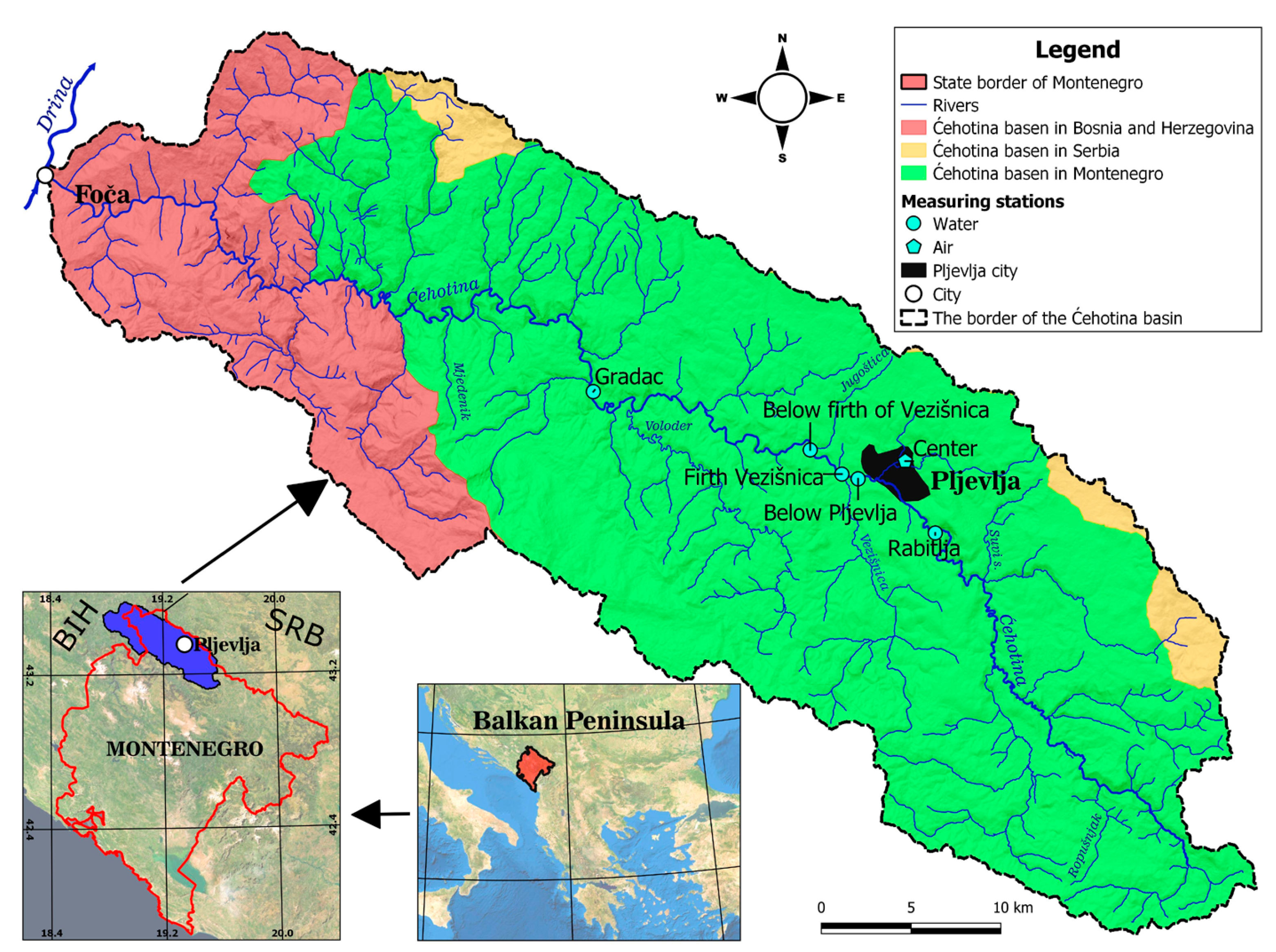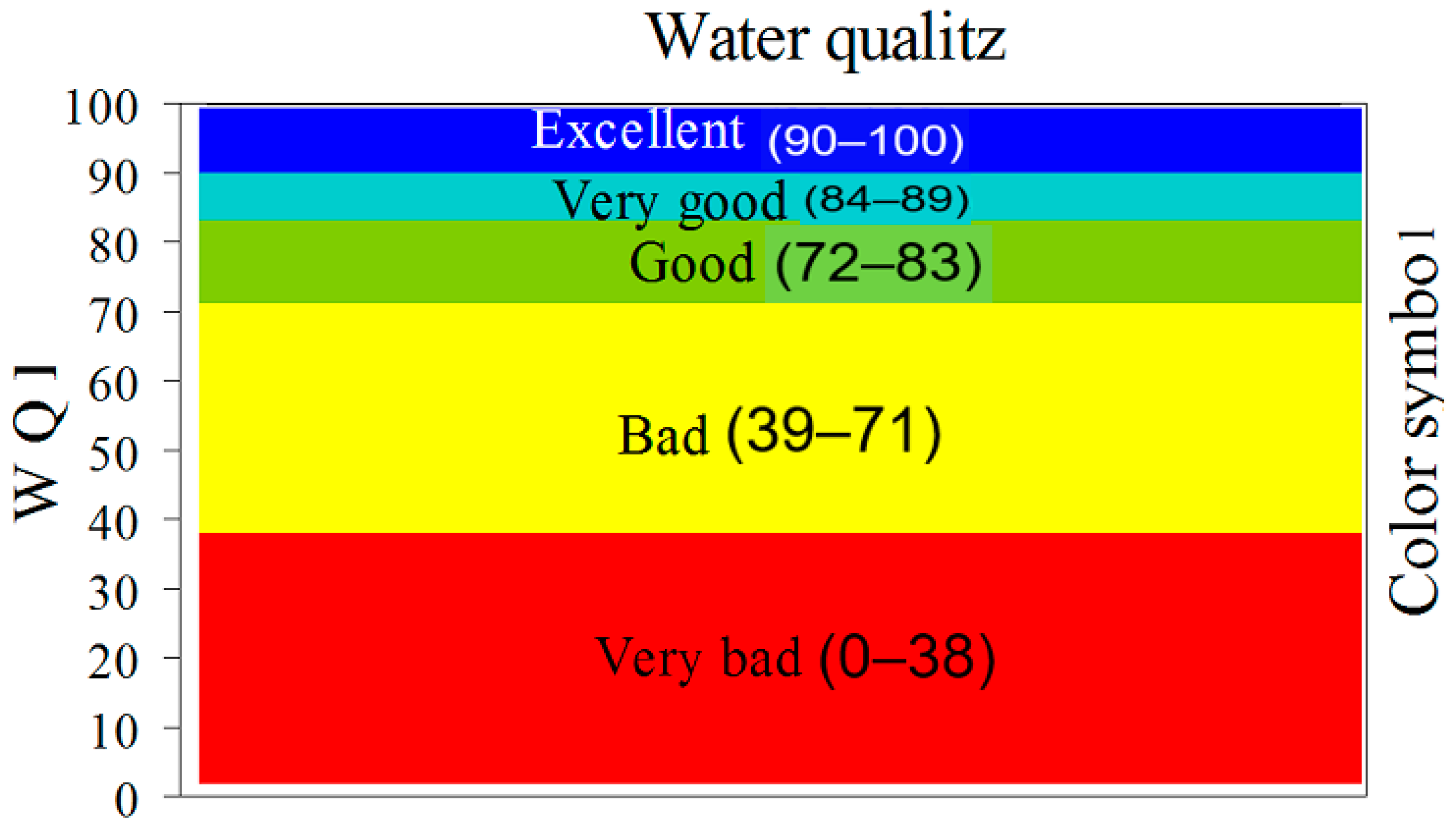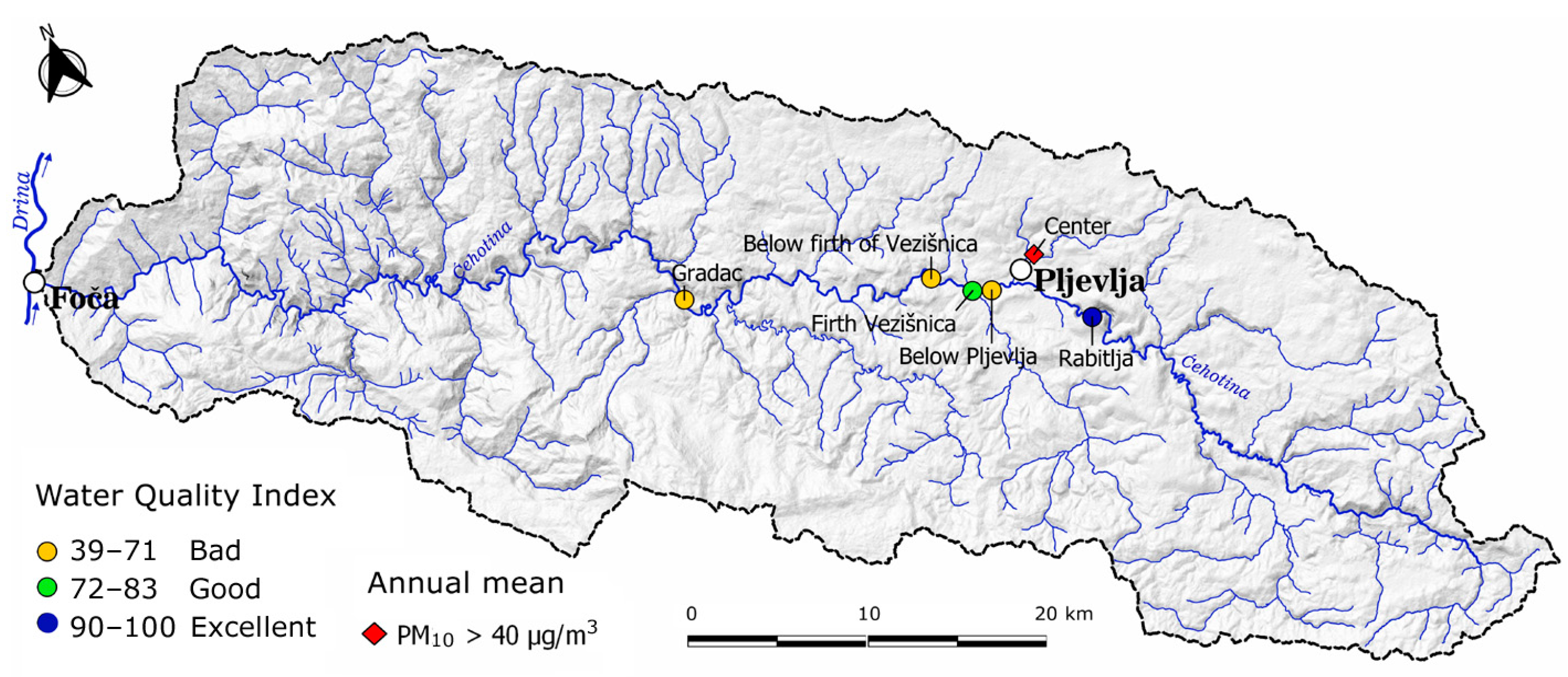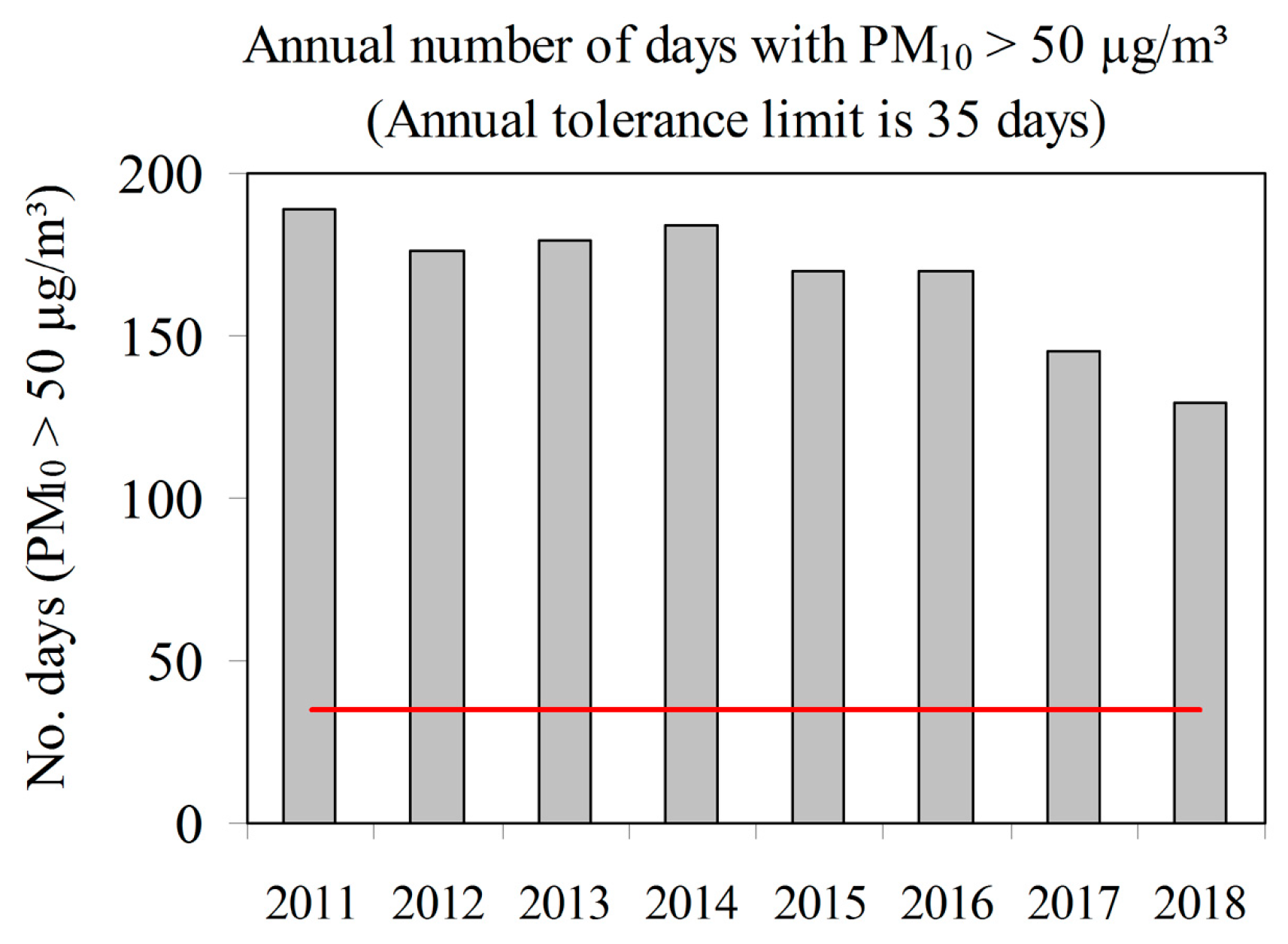Analysis of River Water and Air Pollution—Pljevlja as a “Hot Spot” of Montenegro
Abstract
1. Introduction
2. Research Area, Materials and Methods
2.1. Research Area
2.2. Materials and Methods
3. Results
3.1. Water Quality Index Analysis (WQI)
3.2. Analysis of PM10 Concentration of Suspended Particles
4. Conclusions
Author Contributions
Funding
Institutional Review Board Statement
Informed Consent Statement
Data Availability Statement
Conflicts of Interest
Appendix A
| No. | Parameter | HS Rabitlja | HS Below Pljevlja | ||||||||||||||
|---|---|---|---|---|---|---|---|---|---|---|---|---|---|---|---|---|---|
| (Unit) | 2011 | 2012 | 2013 | 2014 | 2015 | 2016 | 2017 | 2018 | 2011 | 2012 | 2013 | 2014 | 2015 | 2016 | 2017 | 2018 | |
| 1. | WT (°C) | 12.75 | 12.25 | 13.8 | 13.6 | 11.5 | 10.65 | 11.35 | 13.6 | 12.8 | 14.55 | 14.75 | 13.4 | 12.1 | 10.9 | 12.05 | 13.45 |
| 2. | pH (0–14) | 8.4 | 8.1 | 8.1 | 8.2 | 8.1 | 8.1 | 8.1 | 8.1 | 8.2 | 8.1 | 7.9 | 7.9 | 7.9 | 7.9 | 7.8 | 8 |
| 3. | EC (μS/cm) | 303 | 295 | 311 | 309 | 316 | 302 | 309 | 300 | 386 | 400 | 398 | 386 | 393 | 366 | 420 | 364 |
| 4. | SS (mg/L) | 0 | 5 | 1 | 3 | 4 | 4 | 4 | 3 | 6 | 10 | 2 | 1 | 44 | 34 | 17 | 3 |
| 5. | OS (%) | 101.5 | 96 | 98 | 104.5 | 100.5 | 95 | 99 | 103.5 | 88.5 | 76.5 | 79.5 | 93.5 | 82.5 | 90 | 40 | 87.5 |
| 6. | BOD5 (mg/L) | 1.5 | 2.2 | 1.8 | 1.4 | 1.8 | 1.9 | 5.4 | 1.9 | 7.2 | 6.8 | 7.3 | 4.8 | 6 | 3.7 | 7.4 | 4.6 |
| 7. | NH4 (mg/L) | 0.03 | 0.12 | 0.12 | 0.06 | 0.08 | 0.03 | 0.04 | 0.01 | 1.33 | 1.30 | 0.89 | 0.53 | 1.07 | 0.65 | 1.29 | 0.61 |
| 8. | PO4 (mg/L) | 0.06 | 0.07 | 0.08 | 0.07 | 0.05 | 0.09 | 0.03 | 0.03 | 0.39 | 0.35 | 0.3 | 0.24 | 0.38 | 0.29 | 0.46 | 0.25 |
| 9. | NO3 (mg/L) | 1.78 | 1.87 | 1.98 | 3.02 | 2.24 | 2.57 | 1.94 | 1.46 | 2.9 | 3.8 | 3.06 | 5.35 | 4.18 | 4 | 3.07 | 2.87 |
| 10. | CB (MPN in 100 mL) | 286 | 167 | 162 | 222 | 228 | 261 | 41 | 221 | 14550 | 3785 | 7175 | 6410 | 7770 | 3650 | 4000 | 1075 |
| HS Below Firth of Vezišnica | HS Gradac | ||||||||||||||||
| 2011 | 2012 | 2013 | 2014 | 2015 | 2016 | 2017 | 2018 | 2011 | 2012 | 2013 | 2014 | 2015 | 2016 | 2017 | 2018 | ||
| 1. | WT (°C) | 13 | 15.15 | 15.15 | 14 | 12.7 | 10.75 | 12.3 | 13.5 | 12.8 | 14.6 | 15 | 13.35 | 11.9 | 10.7 | 12.3 | 13 |
| 2. | pH (0–14) | 8.3 | 8.2 | 7.9 | 8.1 | 8.2 | 8 | 8 | 8 | 8.4 | 8.3 | 8.2 | 8.3 | 8.3 | 8.2 | 8.2 | 8.1 |
| 3. | EC (μS/cm) | 385 | 387 | 386 | 385 | 389 | 377 | 504 | 399 | 359 | 365 | 373 | 366 | 376 | 351 | 423 | 386 |
| 4. | SS (mg/L) | 1 | 13 | 2 | 3 | 24 | 18 | 21 | 4 | 0 | 15 | 2 | 10 | 17 | 24 | 19 | 27 |
| 5. | OS (%) | 87.5 | 80 | 80 | 95.5 | 83.5 | 89.5 | 68 | 93.5 | 114.5 | 102 | 102 | 110 | 105 | 89.5 | 74 | 109 |
| 6. | BOD5 (mg/L) | 3.9 | 5.6 | 6.7 | 5.4 | 4.6 | 3.7 | 6.7 | 3.1 | 2.9 | 4 | 4.3 | 3 | 2.8 | 4.1 | 6.7 | 4.4 |
| 7. | NH4 (mg/L) | 1.03 | 1.41 | 1.06 | 0.63 | 1 | 0.52 | 3.54 | 0.41 | 0.29 | 0.23 | 0.39 | 0.25 | 0.08 | 0.32 | 1.67 | 0.3 |
| 8. | PO4 (mg/L) | 0.39 | 0.36 | 0.39 | 0.34 | 0.48 | 0.36 | 4.26 | 0.24 | 0.24 | 0.6 | 0.27 | 0.18 | 0.11 | 0.15 | 0.93 | 0.14 |
| 9. | NO3 (mg/L) | 3.23 | 3.8 | 3.64 | 5.91 | 4.31 | 4.18 | 22.37 | 4.27 | 4.57 | 8.8 | 4.53 | 4.68 | 5.42 | 3.86 | 4.92 | 4.28 |
| 10. | CB (MPN in 100 mL) | 12,250 | 2502 | 1400 | 705 | 1150 | 1035 | 10,840 | 755 | 3195 | 1377 | 369 | 625 | 755 | 1990 | 3735 | 255 |
| HS Firth Vezišnica | |||||||||||||||||
| 2011 | 2012 | 2013 | 2014 | 2015 | 2016 | 2017 | 2018 | Definition | |||||||||
| 1. | WT (°C) | 13.2 | 16 | 15.4 | 13.85 | 12.7 | 11.1 | 12.7 | 13.5 | WT—Water temperature | |||||||
| 2. | pH (0–14) | 8.5 | 8.6 | 8.7 | 8.4 | 8.8 | 8.3 | 8.7 | 8.5 | pH value | |||||||
| 3. | EC (μS/cm) | 370 | 386 | 379 | 444 | 460 | 385 | 422 | 417 | EC—Electrical conductivity | |||||||
| 4. | SS (mg/L) | 13 | 6 | 10 | 39 | 12 | 17 | 6 | 9 | SS—Suspended solids | |||||||
| 5. | OS (%) | 87 | 93.5 | 89.5 | 95 | 81.5 | 91 | 87 | 89 | OS—Oxygen saturation | |||||||
| 6. | BOD5 (mg/L) | 1.7 | 3.9 | 5.8 | 2.6 | 2.2 | 1.8 | 5.3 | 2.5 | BOD5—Biochemical oxygen consumption for 5 days | |||||||
| 7. | NH4 (mg/L) | 0.25 | 0.22 | 0.47 | 0.26 | 0.46 | 0.21 | 0.46 | 0.34 | NH4—Ammonium ion | |||||||
| 8. | PO4 (mg/L) | 0.26 | 0.15 | 0.57 | 0.21 | 0.18 | 0.13 | 0.22 | 0.16 | PO4—Orthophosphates | |||||||
| 9. | NO3 (mg/L) | 2.24 | 2.49 | 4.29 | 3.54 | 3.82 | 3.22 | 2.93 | 2.21 | NO3—Total nitrogen oxides | |||||||
| 10. | CB (MPN in 100 mL) | 2325 | 4385 | 1728 | 1145 | 730 | 1250 | 1720 | 747 | CB—Coliform bacteria | |||||||
References
- Dong, H.; Geng, Y.; Sarkis, J.; Fujita, T.; Okadera, T.; Xue, B. Regional water footprint evaluation in China: A case of Liaoning. Sci. Total Environ. 2013, 442, 215–224. [Google Scholar] [CrossRef]
- O’Connell, E. Towards Adaptation of Water Resource Systems to Climatic and Socio-Economic Change. Water Resour. Manag. 2017, 31, 2965–2984. [Google Scholar] [CrossRef]
- Kowalkowski, T.; Zbytniewski, R.; Szpejna, J.; Buszewski, B. Application of chemometrics in river water classification. Water Res. 2006, 40, 744–752. [Google Scholar] [CrossRef] [PubMed]
- Córdoba, E.B.; Martínez, A.C.; Ferrer, E.V. Water quality indicators: Comparison of a probabilistic index and a general quality index. The case of the Confederación Hidrográfica del Júcar (Spain). Ecol. Indic. 2010, 10, 1049–1054. [Google Scholar] [CrossRef]
- Sasakova, N.; Gregova, G.; Takacova, D.; Mojzisova, J.; Papajova, I.; Venglovsky, J.; Szaboova, T.; Kovacova, S. Pollution of Surface and Ground Water by Sources Related to Agricultural Activities. Front. Sustain. Food Syst. 2018, 2, 1–11. [Google Scholar] [CrossRef]
- Kawo, N.S.; Karuppannan, S. Groundwater quality assessment using water quality index and GIS technique in Modjo River Basin, central Ethiopia. J. Afr. Earth Sci. 2018, 147, 300–311. [Google Scholar] [CrossRef]
- Farooqui, K.M.; Sar, S.K.; Diwan, V. Investigation of water quality in Ambur city by water quality indexing. Holist. Approach Environ. 2020, 10, 48–52. [Google Scholar] [CrossRef]
- Cude, C.G. Oregon water quality index a tool for evaluating water quality management effectiveness. Jawra J. Am. Water Resour. Assoc. 2001, 37, 125–137. [Google Scholar] [CrossRef]
- Boyacioglu, H. Development of a water quality index based on a European classification scheme. Water Sa 2009, 33, 101–106. [Google Scholar] [CrossRef]
- Rocha, F.C.; Andrade, E.M.; Lopes, F.B. Water quality index calculated from biological, physical and chemical attributes. Environ. Monit. Assess. 2014, 187, 4163. [Google Scholar] [CrossRef]
- Abuzaid, A.S. Evaluating surface water quality for irrigation in Dakahlia Governorate using water quality index and GIS. J. Soil Sci. Agric. Eng. Mansoura Univ. 2018, 9, 481–490. [Google Scholar]
- Khan, H.; Khan, A.A.; Hall, S. The Canadian Water Quality Index: A tool for water resources management. In Proceedings of the MTERM International Conference, AIT, Pathum Thani, Thailand, 6–10 June 2005; pp. 1–8. [Google Scholar]
- Lumb, A.; Halliwell, D.; Sharma, T. Application of CCME Water Quality Index to Monitor Water Quality: A Case Study of the Mackenzie River Basin, Canada. Environ. Monit. Assess. 2006, 113, 411–429. [Google Scholar] [CrossRef] [PubMed]
- Bharti, N.; Katyal, D. Water quality indices used for surface water vulnerability assessment. International journal of environmental sciences. 2011, 1, 154–173. [Google Scholar]
- Sutadian, A.D.; Muttil, N.; Yilmaz, A.G.; Perera, B. Development of river water quality indices—A review. Environ. Monit. Assess. 2016, 188, 1–29. [Google Scholar] [CrossRef] [PubMed]
- Mititelu-Ionuş, O. Water Quality Index—Assessment method of the Motru river water quality (Oltenia, Romaia). Univ. Craiova Ser. Geogr. 2010, 13, 74–83. [Google Scholar]
- Yisa, J. Analytical Studies on Water Quality Index of River Landzu. Am. J. Appl. Sci. 2010, 7, 453–458. [Google Scholar] [CrossRef]
- Jakovljevic, D. Serbian and Canadian water quality index of Danube river in Serbia in 2010. J. Geogr. Inst. Jovan Cvijicsasa 2012, 62, 1–18. [Google Scholar] [CrossRef]
- Walker, D.; JakovljeviĆ, D.; Savić, D.; Radovanović, M. Multi-criterion water quality analysis of the Danube River in Serbia: A visualisation approach. Water Res. 2015, 79, 158–172. [Google Scholar] [CrossRef]
- Josimov-Dunđerski, J.; Savić, R.; Grabić, J.; Blagojević, B. Water quality of the Danube River in the Pannonian part of its flow through Serbia. Letopis Naučnih Radova/Ann. Agron. 2016, 40, 8–14. [Google Scholar]
- Mladenović-Ranisavljević, I.I.; Žerajić, S.A. Comparison of different models of water quality index in the assessment of surface water quality. Int. J. Environ. Sci. Technol. 2017, 15, 665–674. [Google Scholar] [CrossRef]
- Milijasevic-Joksimovic, D.; Gavrilovic, B.; Lovic-Obradovic, S. Application of the water quality index in the Timok River basin (Serbia). J. Geogr. Inst. Jovan Cvijicsasa 2018, 68, 333–344. [Google Scholar] [CrossRef]
- Babić, G.; Vuković, M.; Voza, D.; Takić, L.; Mladenović-Ranisavljević, I. Assessing Surface Water Quality in the Serbian Part of the Tisa River Basin. Pol. J. Environ. Stud. 2019, 28, 4073–4085. [Google Scholar] [CrossRef]
- Doderovic, M.; Mijanovic, I.; Buric, D.; Milenkovic, M. Assessment of the water quality in the Moraca River basin (Montenegro) using water quality index. Glas. Srp. Geogr. Drus. 2020, 100, 67–81. [Google Scholar] [CrossRef]
- Djurašković, P. Water Quality Index—WQI as Tool of Water Quality Assessment. Available online: http://balwois.com/wp-content/uploads/old_proc/ffp-2026.pdf (accessed on 12 February 2021).
- Vukašinović-Pešić, V.; Blagojević, N.; Savić, A.; Tomić, N.; Pešić, V. The Change in the Water Chemistry of the Rivers of Montenegro over a 10-Year Period. In The Handbook of Environmental Chemistry; Springer: Cham, Switzerland, 2019; Volume 93, pp. 83–109. [Google Scholar]
- Kolarević, S.; Kračun-Kolarević, M.; Jovanović, J.; Ilić, M.; Paunović, M.; Kostić-Vuković, J.; Martinović, R.; Jokanović, S.; Joksimović, D.; Pešić, V.; et al. Microbiological Water Quality of Rivers in Montenegro. Handb. Environ. Chem. 2019, 93, 135–155. [Google Scholar] [CrossRef]
- WHO Regional Office for Europe. Evolution of WHO Air Quality Guidelines: Past, Present and Future; WHO Regional Office for Europe: Copenhagen, Denmark, 2017. [Google Scholar]
- Cohen, A.J.; Brauer, M.; Burnett, R.; Anderson, H.R.; Frostad, J.; Estep, K.; Balakrishnan, K.; Brunekreef, B.; Dandona, L.; Dandona, R.; et al. Estimates and 25-year trends of the global burden of disease attributable to ambient air pollution: An analysis of data from the Global Burden of Diseases Study 2015. Lancet 2017, 389, 1907–1918. [Google Scholar] [CrossRef]
- Vodonos, A.; Abu Awad, Y.; Schwartz, J. The concentration-response between long-term PM2.5 exposure and mortality; A meta-regression approach. Environ. Res. 2018, 166, 677–689. [Google Scholar] [CrossRef]
- WHO. Burden of Disease from Ambient Air Pollution for 2016. Available online: https://www.who.int/airpollution/data/AAP_BoD_results_May2018_final.pdf (accessed on 12 February 2021).
- Karagulian, F.; Belis, C.A.; Dora, C.F.C.; Prüss-Ustün, A.M.; Bonjour, S.; Adair-Rohani, H.; Amann, M. Contributions to cities’ ambient particulate matter (PM): A systematic review of local source contributions at global level. Atmos. Environ. 2015, 120, 475–483. [Google Scholar] [CrossRef]
- Yang, D.; Ye, C.; Wang, X.; Lu, D.; Xu, J.; Yang, H. Global distribution and evolvement of urbanization and PM2.5 (1998–2015). Atmos. Environ. 2018, 182, 171–178. [Google Scholar] [CrossRef]
- Stanojević, G.B.; Miljanović, D.N.; Doljak, D.L.; Ćurčić, N.B.; Radovanović, M.M.; Malinović-Milićević, S.B.; Hauriak, O. Spatio-temporal variability of annual PM2.5 concentrations and population exposure assessment in Serbia for the period 2001-2016. J. Geogr. Inst. Jovan Cvijicsasa 2019, 69, 197–211. [Google Scholar] [CrossRef]
- Fuzzi, S.; Baltensperger, U.; Carslaw, K.; Decesari, S.; Van Der Gon, H.D.; Facchini, M.C.; Fowler, D.; Koren, I.; Langford, B.; Lohmann, U.; et al. Particulate matter, air quality and climate: Lessons learned and future needs. Atmos. Chem. Phys. Discuss. 2015, 15, 8217–8299. [Google Scholar] [CrossRef]
- European Environmental Agency. Air Quality in Europe—2018 Report. 2018. Available online: https://www.eea.europa.eu/publications/air-quality-in-europe-2018/ (accessed on 12 February 2021).
- Vicente, E.; Alves, C. An overview of particulate emissions from residential biomass combustion. Atmos. Res. 2018, 199, 159–185. [Google Scholar] [CrossRef]
- Beelen, R.; Hoek, G.; Brandt, P.A.V.D.; Goldbohm, R.A.; Fischer, P.; Schouten, L.J.; Jerrett, M.; Hughes, E.; Armstrong, B.; Brunekreef, B. Long-Term Effects of Traffic-Related Air Pollution on Mortality in a Dutch Cohort (NLCS-AIR Study). Environ. Heal. Perspect. 2008, 116, 196–202. [Google Scholar] [CrossRef] [PubMed]
- Samoli, E.; Peng, R.; Ramsay, T.; Pipikou, M.; Touloumi, G.; Dominici, F.; Burnett, R.; Cohen, A.; Krewski, D.; Samet, J.; et al. Acute Effects of Ambient Particulate Matter on Mortality in Europe and North America: Results from the APHENA Study. Environ. Heal. Perspect. 2008, 116, 1480–1486. [Google Scholar] [CrossRef]
- Maciejewska, K. Short-term impact of PM2.5, PM10, and PMc on mortality and morbidity in the agglomeration of Warsaw, Poland. Air Qual. Atmos. Health 2020, 13, 659–672. [Google Scholar] [CrossRef]
- IARC. Outdoor Air Pollution a Leading Environmental Cause of Cancer Deaths. 2013. Available online: https://www.iarc.who.int/wp-content/uploads/2018/07/pr221_E.pdf (accessed on 20 March 2021).
- Osnovni Podaci o Termoelektrani “Pljevlja’’ (Basic Information about Thermal Power Plant “Pljevlja”). Available online: https://www.epcg.com/o-nama/termoelektrana-pljevlja (accessed on 7 January 2021).
- MONSTAT. Zavod za Statistiku Crne Gore, MONSTAT (First Results Census of Population, Households and Dwellings in Montenegro). Available online: https://www.monstat.org/userfiles/file/popis2011/saopstenje/knjiga_prvi%20rezultati(1).pdf (accessed on 13 January 2021).
- Hrvačević, S. Resursi površinskih voda Crne Gore; Elektroprivreda Crne Gore A.D. Nikšić: Nikšić, Podgorica, 2004; p. 331. [Google Scholar]
- Zavod za Hidrometeorlogiju i Seizmologiju Crne Gore (Institute of Hydrometeorology and Seismology of Montenegro.). Godišnji Izvještaji za Period 2011–2018 (Annual Reports for the Period 2011–2018). Available online: http://www.meteo.co.me/ (accessed on 15 January 2021).
- Buric, D.; Ducic, V.; Mihajlovic, J. The climate of Montenegro: Modificators and types - part two. Glas. Srp. Geogr. Drus. 2014, 94, 73–90. [Google Scholar] [CrossRef]
- Centar za Ekotoksikološka Istraživanja Crne Gore (Center for Eco-Toxicological Research of Montenegro.). Godišnji Izvještaji za Period 2011–2018 (Annual Reports for the Period 2011–2018). Available online: http://mne.ceti.me/ (accessed on 6 March 2021).
- Lopes, F.B.; Teixeira, A.S.; Andrade, E.M.; Aquino, D.N.; Araújo, L.F.P. Mapa da qualidade das águas do rio Acaraú, pelo emprego do IQA e Geoprocessamento (Map of Acaraú River water quality by the use of WQI and GIS.). Revista Ciência Agronômica 2008, 39, 392–402. [Google Scholar]
- Hurley, T.; Sadiq, R.; Mazumder, A. Adaptation and evaluation of the Canadian Council of Ministers of the Environment Water Quality Index (CCME WQI) for use as an effective tool to characterize drinking source water quality. Water Res. 2012, 46, 3544–3552. [Google Scholar] [CrossRef]
- Garcia, C.A.B.; Silva, I.S.; Mendonça, M.C.S.; Garcia, H.L. Evaluation of Water Quality Indices: Use, Evolution and Future Perspectives. Adv. Environ. Monit. Assess. 2019, 18. [Google Scholar] [CrossRef]
- Hernea, C.; Teche-Constantinescu, A.M. Variability of groundwater quality parameters from periurban area of Timisoara (Romania). J. Environ. Prot. Ecol. 2013, 14, 64–70. [Google Scholar]
- Lumb, A.; Sharma, T.C.; Bibeault, J.-F. A Review of Genesis and Evolution of Water Quality Index (WQI) and Some Future Directions. Water Qual. Expo. Health 2011, 3, 11–24. [Google Scholar] [CrossRef]
- EU. Directive on Ambient Air Quality and Cleaner Air for Europe. Available online: https://eur-lex.europa.eu/legal-content/EN/TXT/PDF/?uri=CELEX:32008L0050&from (accessed on 10 March 2021).
- WHO. Ambient (Outdoor) Air Pollution. Available online: www.who.int/mediacentre/factsheets/fs313/en/index.html (accessed on 6 March 2021).
- Burić, D.; Stanojević, G. Trends and possible causes of cloudiness variability in Montenegro in the period 1961–2017. Clim. Res. 2020, 81, 187–205. [Google Scholar] [CrossRef]
- Ministarstvo Održivog Razvoja i Turizma Crne Gore (Ministry of Sustainable Development and Tourism of Montenegro.). Nacionalna Strategija Upravljanja Kvalitetom Vazduha sa Akcionim Planom za Period 2013–2016. (National Air Quality Management Strategy with Action Plan for the Period 2013–2016). Available online: https:///Nacionalna%20strategija%20upravljanja%20kvalitetom%20vazduha%20sa%20Akcionim%20planom.pdf (accessed on 11 March 2021).





| River | Hydrological Station | Mean Annual Values of WQI | Trend (WQI/year) | Correlation | ||||||||
|---|---|---|---|---|---|---|---|---|---|---|---|---|
| 2011 | 2012 | 2013 | 2014 | 2015 | 2016 | 2017 | 2018 | WQI-P | WQI-T | |||
| Ćehotina | Rabitlja | 90 | 68 | 90 | 90 | 92 | 89 | 86 | 94 | 0.14 | 0.10 | 0.36 |
| Ćehotina | Below Pljevlja | 59 | 74 | 60 | 68 | 56 | 66 | 46 | 68 | 0.17 | 0.60 | 0.25 |
| Ćehotina | Below firth of Vezišnica | 64 | 72 | 59 | 65 | 59 | 68 | 44 | 74 | 0.19 | 0.49 | 0.19 |
| Ćehotina | Gradac | 75 | 78 | 73 | 75 | 82 | 71 | 53 | 72 | −1.13 | 0.01 | −0.26 |
| Vezišnica | Firth Vezišnica | 77 | 77 | 64 | 73 | 71 | 79 | 67 | 78 | 0.00 | 0.17 | −0.12 |
| Parameter | Limit Value | Tolerance Limit |
|---|---|---|
| Daily mean (PM10) | 50 µg/m3 | 35 times per year |
| Annual mean (PM10) | 40 µg/m3 | / |
| Parameter | Winter | Spring | Summer | Autumn | Annual |
|---|---|---|---|---|---|
| Trend PM10 | 0.45 | −2.82 * | −1.29 | −4.56 ** | −3.88 * |
| C (PM10 and P) | −0.51 | 0.20 | −0.76 * | −0.54 | −0.48 |
| C (PM10 and T) | 0.04 | −0.89 ** | 0.23 | −0.33 | −0.87 ** |
Publisher’s Note: MDPI stays neutral with regard to jurisdictional claims in published maps and institutional affiliations. |
© 2021 by the authors. Licensee MDPI, Basel, Switzerland. This article is an open access article distributed under the terms and conditions of the Creative Commons Attribution (CC BY) license (https://creativecommons.org/licenses/by/4.0/).
Share and Cite
Doderović, M.; Burić, D.; Mijanović, I.; Premović, M. Analysis of River Water and Air Pollution—Pljevlja as a “Hot Spot” of Montenegro. Sustainability 2021, 13, 5229. https://doi.org/10.3390/su13095229
Doderović M, Burić D, Mijanović I, Premović M. Analysis of River Water and Air Pollution—Pljevlja as a “Hot Spot” of Montenegro. Sustainability. 2021; 13(9):5229. https://doi.org/10.3390/su13095229
Chicago/Turabian StyleDoderović, Miroslav, Dragan Burić, Ivan Mijanović, and Marijan Premović. 2021. "Analysis of River Water and Air Pollution—Pljevlja as a “Hot Spot” of Montenegro" Sustainability 13, no. 9: 5229. https://doi.org/10.3390/su13095229
APA StyleDoderović, M., Burić, D., Mijanović, I., & Premović, M. (2021). Analysis of River Water and Air Pollution—Pljevlja as a “Hot Spot” of Montenegro. Sustainability, 13(9), 5229. https://doi.org/10.3390/su13095229






